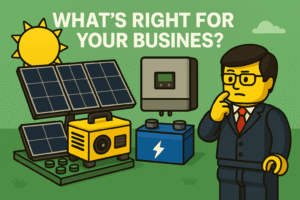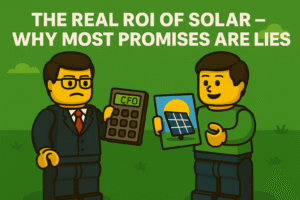Most businesses know they should be doing something about energy.
Solar. Backup. Batteries. Tariffs. Sustainability.
But between overloaded teams, limited capital, and “more urgent” fires, energy strategy gets parked in the “we’ll get to it next year” folder.
On paper, that looks like a neutral decision.
In reality, it’s not neutral at all.
Doing nothing is a decision. And it carries its own very real cost.
Let’s talk about that.
1. The Cost of Rising Tariffs (That You’re Just Absorbing)
Every year, electricity costs climb. Not by 2–3%. Often by double digits.
If your business:
- Uses a lot of power
- Runs extended hours
- Operates energy-heavy equipment
…then tariff increases quietly compound in the background.
What this really means:
- Your cost of sales is climbing
- Your margins are being squeezed
- Your prices need to go up just to stand still
If you haven’t built any kind of hedge (solar, load shifting, efficiency, negotiated tariffs), you’re effectively betting your margins on Eskom and your municipality.
That’s not risk management. That’s roulette.
(Read: How to Future-Proof Your Business Against the tariff trap.)
2. The Cost of Unpredictability
CFOs don’t just hate high costs.
They hate unpredictable costs.
If you can’t reasonably forecast what your power will cost in 2–3 years, then:
- Long-term pricing becomes guesswork
- Multi-year contracts become riskier
- Budgeting becomes defensive instead of strategic
Doing nothing about energy means baking uncertainty into your business model.
And uncertainty is expensive.
3. The Cost of Downtime & Disruption
Even if load shedding has eased, it hasn’t disappeared.
And then there’s:
- Localised outages
- Faulty infrastructure
- Cable theft
- Substations failing
Every unplanned downtime event hits:
- Revenue (lost production or trading hours)
- Staff productivity and morale
- Customer trust
You might think, “We survived it.”
But how often? At what total cost?
If you added up lost hours over the last 2–3 years, the payback period on a sensible backup or hybrid solution might already have passed.
4. The Cost of Missing Incentives & Momentum
Energy and sustainability are increasingly tied to:
- Finance terms
- Tenders and supply chain requirements
- ESG reporting and investor decisions
By doing nothing, you’re not just avoiding a capex decision.
You might be:
- Losing tenders to more “credible” competitors
- Looking riskier to banks and investors
- Missing out on good will and PR that you can’t buy later
There’s a window where early movers get rewarded.
Late adopters just scramble to comply.
(Read: Sustainability and Your Balance Sheet.)
5. The Cost of Strategy Drift
This is the one almost no one talks about.
If you keep telling your team and your market:
“We’re serious about resilience, growth and sustainability.”
…but your energy reality is:
- No roadmap
- No formal plan
- No progress year-on-year
Then you’ve got a credibility gap.
Internally, your team learns:
“We say big things. We don’t move on them.”
Externally, your message becomes generic.
You look like everyone else.
Energy strategy isn’t the whole story, but it’s a very visible proof point of whether you do what you say.
6. The “Wait Until It’s Perfect” Trap
A lot of leaders are waiting for:
- The perfect policy environment
- The perfect capex moment
- The perfect technology option
Here’s the uncomfortable truth:
If you wait for perfect conditions, you’ll still be stuck in five years – just with higher costs and less room to move.
You don’t need a moonshot.
You need a sensible, staged roadmap:
- Stage 1: Understand your exposure (tariffs, downtime, risk).
- Stage 2: Implement the low-hanging fruit (efficiency, basic backup, monitoring).
- Stage 3: Layer in solar, storage and tariff strategies as the business can handle them.
Perfect is not the goal.
Progress is.
Doing nothing about energy isn’t “saving money until later.”
It’s choosing:
- Higher and more volatile costs
- More risk and less control
- Lower competitiveness over time
You’re already paying for energy.
The question is whether you’re paying blindly or investing strategically.
If energy has been sitting on your “we’ll get to it” list for too long, it’s time to bring it into the strategy room.
Let’s map:
- What doing nothing is really costing you
- Where the biggest risks and opportunities sit
- What a realistic 12–36 month energy roadmap could look like
And if you haven’t yet, start with the Solar & Backup Decision Checklist and Solar Quote Checklist – they’ll help you see where you stand before you spend a cent.
Let’s build your legacy Together
Book a free call to chat about where you need help


